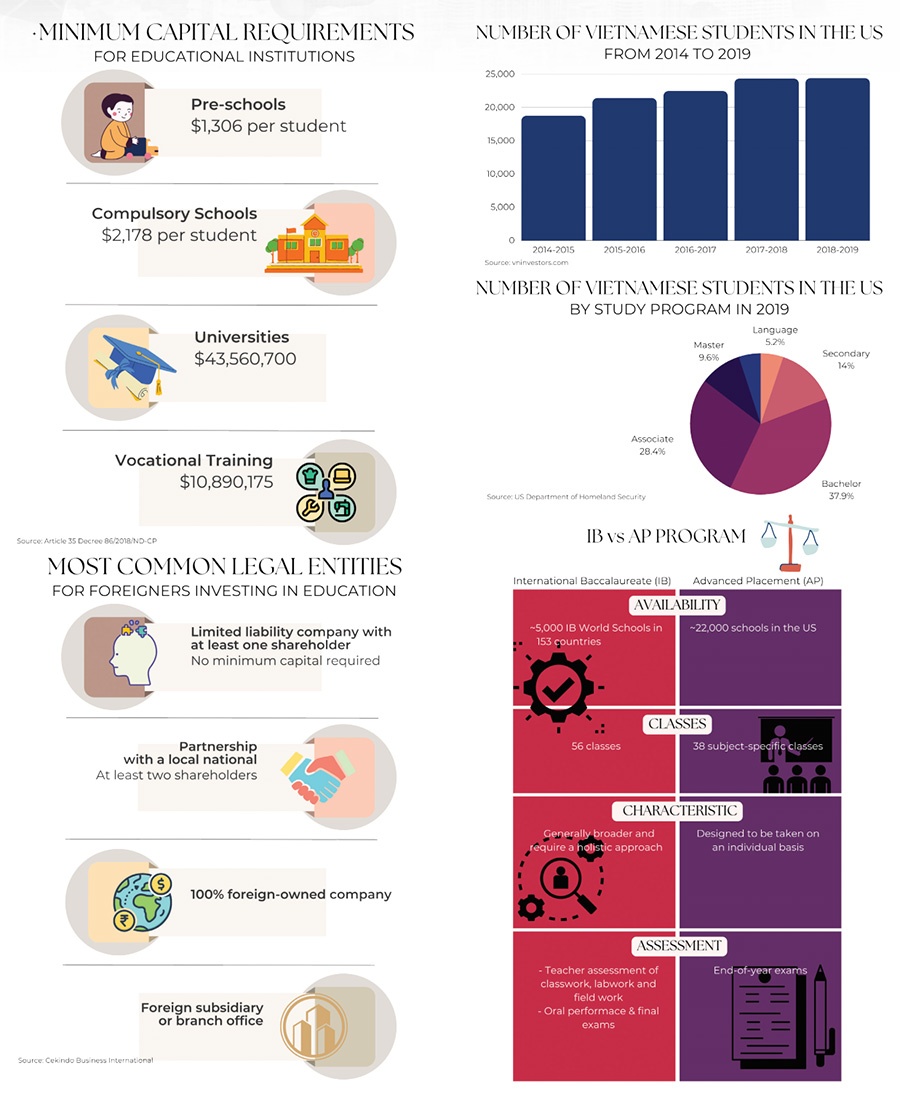Local education ripe for levelling-up
The latest statistics from the Ministry of Planning and Investment show that as of April 20, 607 foreign cooperation projects have been operational in Vietnam’s education and training sector, with the total investment capital of more than $4.44 billion.
 |
| Local education ripe for levelling-up, illustration photo/ source: freepik |
The US, the United Kingdom, and Singapore have been the top educational investors in the past two years, with funding in schools slowing down last year due to long periods of closure – but momentum is being quickly regained.
In 2018, the Vietnamese government issued Decree No.86/2018/ND-CP on foreign cooperation and investment in education and training, aiming to develop the private sector. An important part of this decree is the quota increase of the number of local student enrolments allowed in international schools, from 10 per cent for primary school and 20 per cent for secondary school to 50 per cent for all grade levels. Experts believe that this adjustment has transformed the country into a booming market for international schools, most of which adopted British, American, or Australian curriculums.
Furthermore, Vietnam’s commitments to the World Trade Organization (WTO) have made fully foreign-invested educational institutions possible.
“At the same time, investors can now find new opportunities. Nearly 60 per cent of Vietnam’s population is under 35 years of age. Education remains a national priority for the country as it believes it will determine the national economic success,” advisory firm Dezan Shira & Associates reported.
Tran Thang, president of the Vietnam Institute of Culture and Education in the US, said, “More and more middle-class families are aiming for their children to attend English-speaking international schools, so that it’s easier for them to attend universities in English-speaking countries, including the US.”
 |
In fact, Vietnam was ranked sixth in the world and first in ASEAN countries in terms of the number of international students in the US, in the 2019-2020 school year.
“More than 20,000 Vietnamese students are studying in the US every year and their universities are increasingly sought-after destinations for Vietnamese students. So I believe there is more potential for American education investment in Vietnam because the market clearly is interested,” noted William Badger, chairman of the Education and Workforce Development Committee at the American Chamber of Commerce in Vietnam (AmCham).
According to a report by Grant Thornton Vietnam, kindergartens and K-12 schools are the segments that would continue to see the biggest investments, including new establishments, mergers and acquisitions, and also some private equity transactions.
The influx of foreign capital is also causing enormous changes in the country’s educational environment, especially in the curriculum structure. International schools, which are either fully foreign-funded or established by partnerships between the Ministry of Education and Training (MoET) and the Ministry of Foreign Affairs, generally have the freedom to select their curriculum. Currently, there are 12 schools that are recognised by the MoET as international schools.
Traditionally, the International Baccalaureate (IB) has been the most sought-after curriculum for this segment. However, American models like the advanced placement (AP) and common core state standard (CCSS) have been gaining popularity in the last five years.
“The AP model gives schools the opportunity to run unique programmes, whereas IB offers far less flexibility. In the AP programme, students have a chance to earn a lot more college credits, while loading up in areas of interest,” Badger of AmCham assessed.
On a bigger scale, even local or joint-venture institutions are affected by this outward educational trend. A number of private or semi-private schools are also adopting some version of international curricula in addition to their MoET standard programme.
“The application of CCSS to the curriculum has helped our students perfect their skills and overcome their weaknesses. This can be seen as a big step forward in education and solves problems that have existed for many years,” said Anthony Roberti, president of the International School of South America, a new school in Ho Chi Minh City that follows both the MoET and American curriculum.
What the stars mean:
★ Poor ★ ★ Promising ★★★ Good ★★★★ Very good ★★★★★ Exceptional
 Tag:
Tag:
Related Contents
Latest News
More News
- Global partnerships key to Vietnam’s IFC development (December 26, 2025 | 16:18)
- Vingroup pulls out of bid to invest in North-South high-speed railway (December 26, 2025 | 11:42)
- Strengthening supply chains through trade promotions and customs reform (December 24, 2025 | 14:00)
- PM orders investment model for North–South high-speed rail (December 22, 2025 | 17:43)
- LS Eco Energy to invest in Vietnam rare earth sector (December 22, 2025 | 17:31)
- Government moves to establish International Financial Centre (December 21, 2025 | 21:00)
- Vietnam's IFC to target global investment flows (December 21, 2025 | 18:00)
- Two national hospitals expand capacity with new facilities (December 20, 2025 | 09:00)
- Ha Tinh breaks ground on major Vingroup industrial and energy projects (December 19, 2025 | 18:24)
- EVN launches major power infrastructure projects nationwide (December 19, 2025 | 18:17)























 Mobile Version
Mobile Version